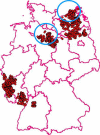The control of classical swine fever in wild boar
- PMID: 26594202
- PMCID: PMC4635204
- DOI: 10.3389/fmicb.2015.01211
The control of classical swine fever in wild boar
Abstract
Classical swine fever (CSF) is a viral disease with severe economic consequences for domestic pigs. Natural hosts for the CSF virus (CSFV) are members of the family Suidae, i.e., Eurasian wild boar (sus scrofa) are also susceptible. CSF in wild boar poses a serious threat to domestic pigs. CSFV is an enveloped RNA virus belonging to the pestivirus genus of the Flaviviridae family. Transmission of the infection is usually by direct contact or by feeding of contaminated meat products. In recent decades CSF has been successfully eradicated from Australia, North America, and the European Union. In areas with dense wild boar populations CSF tends to become endemic whereas it is often self-limiting in small, less dense populations. In recent decades eradication strategies of CSF in wild boar have been improved considerably. The reduction of the number of susceptible animals to a threshold level where the basic reproductive number is R 0 < 1 is the major goal of all control efforts. Depending on the epidemiological situation, hunting measures combined with strict hygiene may be effective in areas with a relatively low density of wild boar. Oral immunization was shown to be highly effective in endemic situations in areas with a high density of wild boar.
Keywords: classical swine fever; control; oral vaccination; wild boar; wildlife diseases.
Figures


References
-
- Acevedo P., Quirós-Fernández F., Casal J., Vicentec J. (2014). Spatial distribution of wild boar population abundance: basicinformation for spatial epidemiology and wildlife management. EcolIndic. 36, 594–600. 10.1016/j.ecolind.2013.09.019 - DOI
-
- Alexandrov T., Kamenov P., Stefanov D., Depner K. (2011). Trapping as an alternative method of eradicating classical swine fever in a wild boar population in Bulgaria. Rev. Sci. Tech. OIE. 3033, 911–916. - PubMed
-
- Anonymous (1999). Classical Swine Fever in Wild Boar.:XXIV/B3/R09/1999. Available online at: http://ec.europa.eu/food/fs/sc/scah/out24_en.pdf
-
- Anonymous (2002). COMMISSION DECISION approving a Diagnostic Manual establishing diagnostic procedures, sampling methods and criteria for evaluation of the laboratory tests for the confirmation of classical swine fever. Official J. Eur. Commun. L 39, 71–88.
Publication types
LinkOut - more resources
Full Text Sources
Other Literature Sources

